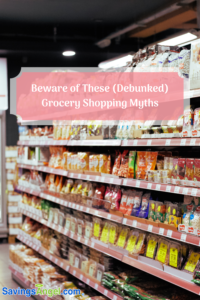Beware of These (Debunked) Grocery Shopping Myths

Most of us conduct our daily activities without giving them much thought, especially when it comes to the hidden details. We don’t often stop and think about whether or not there’s a better (or cheaper) way to do things, especially when it comes to grocery shopping. Well, in the spirit of innovation, here are a few grocery shopping myths we’ve debunked for you to help you better optimize your shopping trips.
Shop Pound for Pound
A common shopping myth is that you spend a lot when you buy items priced by the pound. Buying a family-size box of cereal, which can cost you around $5 for brand-name cereals, is way more expensive than purchasing, say, bananas at 59 cents per pound. You could buy nine pounds of bananas for about the price of that box of cereal. Not only can you eat healthier if you’re buying more produce (which is often priced by the pound), you’re also saving money. You get a better bang for your buck, so be open-minded to buying food by the pound.
Shopping at More Than One Store
Yes, at face value, shopping at more than one store for your groceries seems time-consuming. However, an easy fix for this is following a list that you don’t deviate from and cherry-picking the deals at each store. Hopefully, the stores you shop at aren’t far from one another. If they’re close in proximity, you stick to your list, and you shop only for what you need (e.g. what’s on your pre-planned list), you don’t wander aimlessly for what you need, you don’t buy extras, and you speed through the shopping process. You can save a ton of money and time this way — that’s right. You can save money and time by shopping at multiple stores if you plan ahead.
Is Organic Better?
At a cursory glance, shopping for only organic produce seems like the healthiest option. However, this isn’t always the case. Yes, organic produce lacks the same pesticides that regular produce might contain, but for some items, this is a non-issue according to the Environmental Working Group. Fruits and veggies with rinds (oranges, avocados, bananas, etc.) won’t contain contaminated edible fruit. If you wash them off, as you should with all produce (organic or not), you’re perfectly safe and didn’t pay extra for organic produce. Pay close attention to the price differences between organic and regular produce and choose carefully when you shop for these items.
Buying in Bulk
Is buying in bulk always a deal? Well, it depends. For some items, shopping in bulk is a great idea, especially at wholesale prices. Things like toiletries, toilet paper, soap, and more are great bulk items. However, other bulk purchases might be unwise. If you buy perishable items in bulk, will you be able to finish it before it expires and needs to be tossed? If you’re buying sugary, processed items in bulk, you’re setting yourself up for an extended period of eating those items. If you decide to diet or change your eating lifestyle, you won’t want to waste these items. You might find yourself ‘on the hook’ to finish these items, which postpones or completely cancels out any decisions to eat better. Buy in bulk conscientiously and be mindful of what you’re stocking up on.


